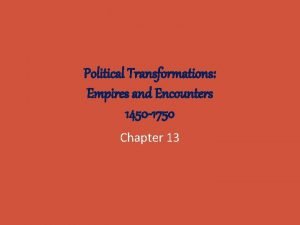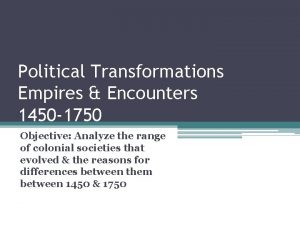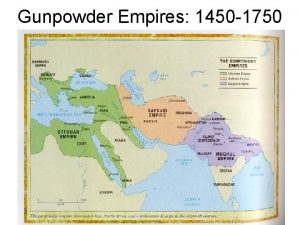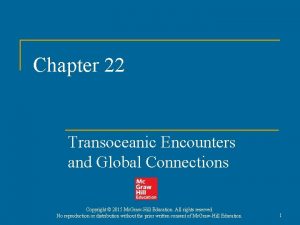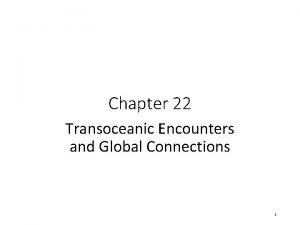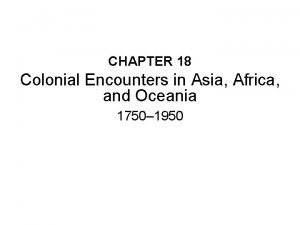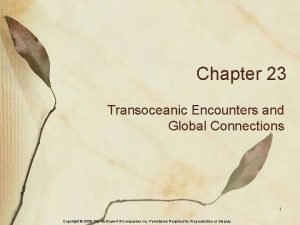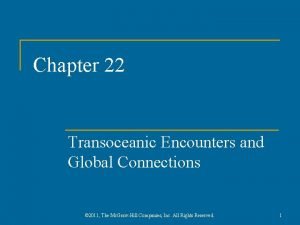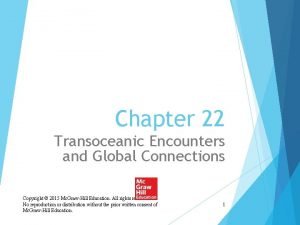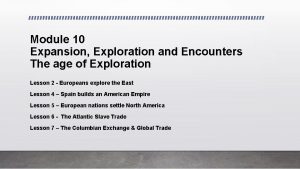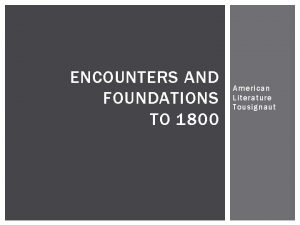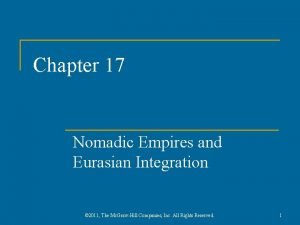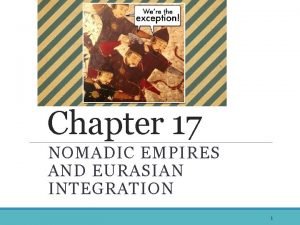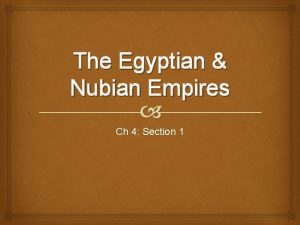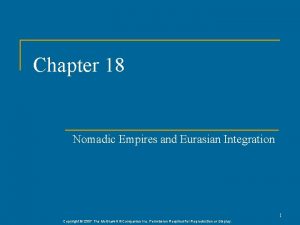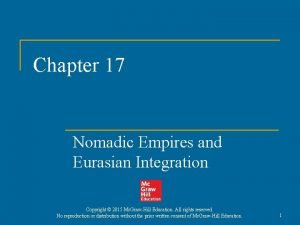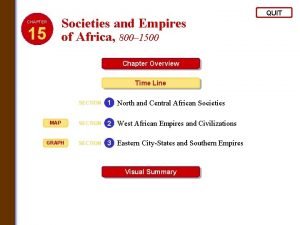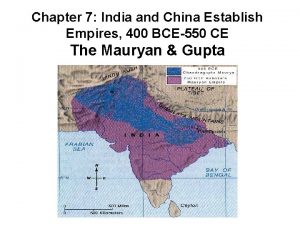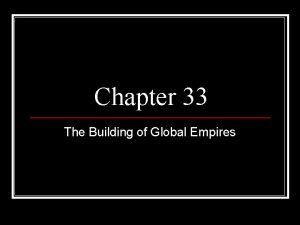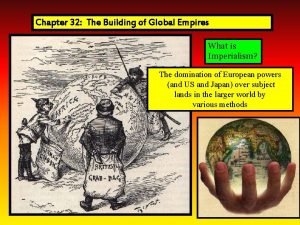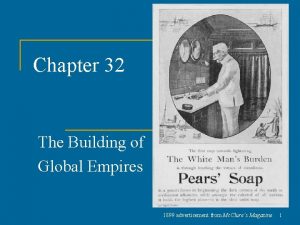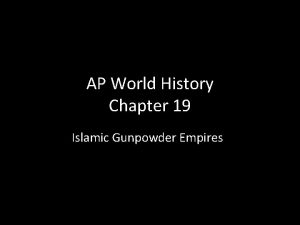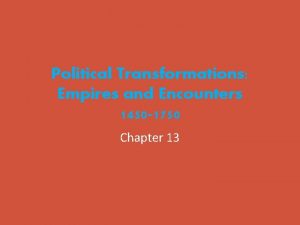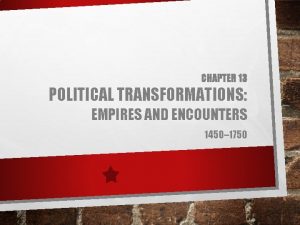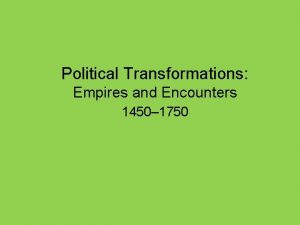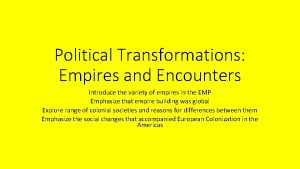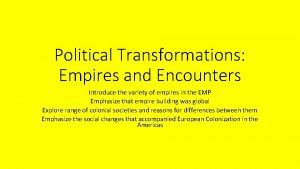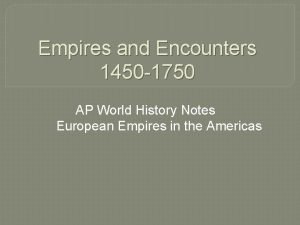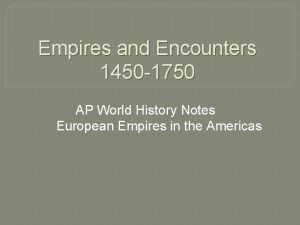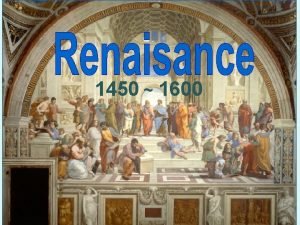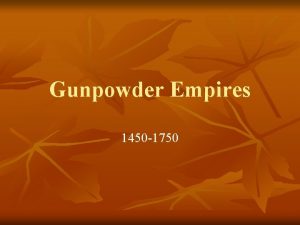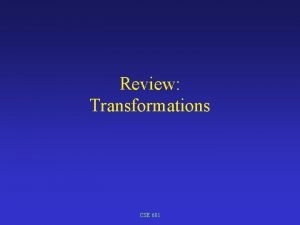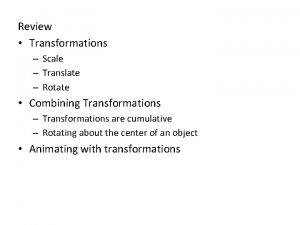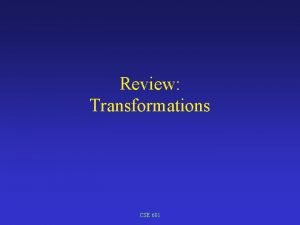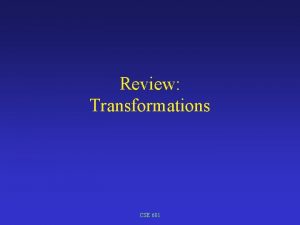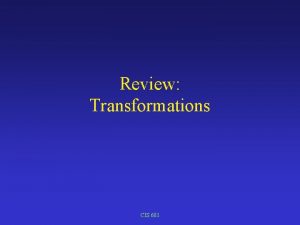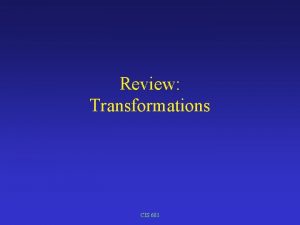Political Transformations Chapter 13 Empires and Encounters 1450

































- Slides: 33

Political Transformations Chapter 13 – Empires and Encounters, 1450 – 1750

Map of European Colonial Empires in the Americas

European Empires in the Americas �The Spaniards in Caribbean, then expanded to Aztec and Inca Empires. �The Portuguese in Brazil. �The English (later British), French, and Dutch colonies in North America. �The Europeans controlled most of the Americas by the mid-eighteenth century.

The European Advantage �Geography – the Atlantic’s fixed winds helped, once they were understood, making travel “easier. ” �Need – the Chinese, Indians, and Muslims had such rich markets in the Indian Ocean web that there wasn’t much incentive to go beyond their own waters. �Marginality – Europeans were aware of their marginal position in Eurasian commerce and wanted to gain access to that world. �Rivalry – interstate rivalry drove rulers to compete. �Merchants – the growing merchant class wanted direct access to Asian wealth.

More European Advantages �Wealth and Status – the colonies were an opportunity for impoverished nobles and commoners. �Religion: - crusading zeal to enlarge Christendom. - persecuted minorities wanted religious freedom. �Technology: - iron, gunpowder weapons, and horses gave Europeans an initial advantage over the native people in the Americas. - better seafaring technology than natives in the Americas. �Rivalries within Americas helped Europeans make allies in the Americas.

The Great Dying �The single greatest advantage was one the Europeans did not understand, but carried with them wherever they went: a whole host of infectious diseases. �Pre-Columbian Americas: 60 -80 million people. �Disease: over 90% died from Small Pox, Typhus; etc. �It was not until the late-seventeenth century that the population began to recover, but in only some places.

The Columbian Exchange �The Columbian Exchange: - labor shortage due to natives immune to diseases. - Europeans and Africans create a new society. - plants (okra and rice) and animals (horses, pigs; cattle) brought to the Americas. - corn and potatoes create population growth in the Eastern Hemisphere. �American tobacco and chocolate, Chinese tea and silk, European wool and linen, Indian cotton, and Arab coffee: people began to consume a variety of stimulants from around the world.

The Exchange (Cont’d) �Global networks transported commodities such as silver from the Potosí mine in the Andes, human beings from Africa, and sugar increasingly from the Caribbean. New producers and transporters became fabulously wealthy in this process. �Europeans received most of the rewards: - new information helped lead to the Scientific Revolution. - the colonies were an outlet for rapidly expanding European population. - shift in the global balance of power to favor Europe.

Map of the Columbian Exchange

Colonial Societies in the Americas �Mercantilism – theory that governments should encourage exports and accumulate bullion to serve their countries. �Colonies should provide closed markets for the mother country’s manufactured goods. �The colonies, however, differed widely, depending on the native cultures and the sorts of economy that were established.

In the Lands of the Aztecs and the Incas �The Spanish gained access to the most wealthy, populous, and urbanized regions in the Americas. �Economy – commercial agriculture and the mining of gold and silver. �In the legal system (encomienda), native people provided forced labor for Spanish settlers. �Creation of a distinctive social order: - class hierarchy based on race. - largely self-governed (with permission from the Crown).

In the Lands of the Aztecs and the Incas (Cont’d) �Peninsulares – white, born in the Iberian Peninsula and living in Americas. �Creoles – white, but born in the Americas. �Mestizo – white and native American. �Mulatto – white and black. �At the bottom – Native American. �There were over 30 specific classes based on race. �There was much more inter-racial children in S. America than in N. America

Hernando Cortes

Colonies of Sugar �Brazil and the Caribbean were used for growing sugar: - the sugar was grown solely for export. �There was a huge demand for sugar in Europe. �Production was labor intensive, worked best on large-scale: - it can be referred to as the first modern industry. - had always been produced with massive use of slave labor. - Indians of the area were almost totally wiped-out or fled. - planters turned to African slaves: 80 percent of all Africans enslaved in the Americas ended up in Brazil and the Caribbean. Populations of mixed-race mulattoes.

Colonies of Sugar (Cont’d) �Plantation system began to be used in southern parts of North America: - but in North America, European women came earlier. - result was less racial mixing, less tolerance toward mixed blood. - sharply defined racial system evolved. - slavery was less harsh in North America. �Freeing a slave was more common in Brazil, and they had more economic opportunities.

Caribbean Plantation Life

Settler Colonies in North America �British got in the “game” late: - this is why they wound up in New England, NY; PA. �Great Britain and Ireland at the time: - Catholic/Protestant conflict. - rise of a merchant capitalist class (not nobility). - major cloth industry. - development of Parliament, breakdown of feudalism. �British colonists were trying to escape British society: - brought women with them in early stages.

Settler Colonies in North America (Cont’d) �British settlers were more numerous; by 1750, they outnumbered Spaniards in New World by five-to-one. �Small-scale, independent farming – didn’t need slaves. �Protestant England didn’t push for Christian conversion. �The Protestant emphasis on reading the Bible for oneself led to higher literacy among colonists. �The power struggle between the king and Parliament in Britain created a distraction, allowing autonomy and self -government for the colonists. There was no elaborate royal bureaucracy like in South America.

Puritans Arriving in New England

Map of the Russian Empire

The Making of a Russian Empire �A small Russian state around Moscow (Muscovy) emerged around 1500: - Moscow began to conquer neighboring cities. - over three centuries it grew into a massive empire. - early expansion into the grasslands to south and east was for security against pastoral nomads. - expansion into Siberia was a matter of opportunity (especially furs), not threat. –Cossacks, bands of independent Siberian warriors and peasants whom were absorbed into the growing Russian state.

Experiencing the Russian Empire �Defeated peoples swore allegiance to the czar and paid tribute (yasak). �Russian elites were known as boyars, followed by merchants and then serfs at the bottom. �Conquest brought devastating epidemics, especially in remote areas of Siberia. The local population had no immunity to smallpox and measles. �Pressure to convert to Christianity. �Some tolerance of Islamic subjects (Catherine the Great). �Russia (fees) discouraged pastoralism in Siberia.

Russians and Empire �Rich agricultural lands, furs, and minerals helped make Russia a great power by the eighteenth century. �Became an Asian power as well as a European one. �Expansion made Russia a very militarized state. �Colonization experience was different from the Americas: - conquest of territories with which Russia had long interacted. - conquest took place at the same time as development of the Russian state. - the Russian Empire remained intact until 1991.

Map of Chinese Empire

Making China an Empire �Asian empires were regional, and not global. �Qing dynasty (1644– 1912) launched an enormous imperial expansion to the north and west. �Qing or Manchu were nomads who conquered China: - 80 -year-long Chinese conquest (1680– 1760). � Conquered territory was ruled separately from the rest of China through the Court of Colonial Affairs: - Chinese didn’t try to assimilate conquered people. - little Chinese settlement in conquered areas. �Russia and China destroyed the nomadic societies of central Asia.

Map of the Mughal Empire

Muslims and Hindus in the Mughal Empire �Mughals united much of India between 1526 and 1707. �Religious divide: 20% Muslim and 80% Hindu. �Emperor Akbar (r. 1556– 1605) attempted serious accommodation of the Hindu majority: - brought many Hindus into the political-military elite after conquering the warrior-based Hindu Rajputs. - imposed a policy of toleration. - abolished payment of jizya by non-Muslims. - created a state cult that stressed loyalty to the emperor. �Many Muslims disliked this policy of “toleration. ”

Emperor Akbar and his Wife

Mughal Empire (India) �Emperor Aurangzeb (r. 1658– 1707) reversed Mughal policy, and tried to impose Islamic supremacy: - banned sati (widow burning), music and dance at court; various vices (gambling, drinking, etc. ): - destruction of some Hindu temples. - brought back the jizya tax. �Aurangzeb’s policy provoked Hindu reaction. �Opposition movements fatally weakened the Mughal Empire after 1707, paving the way for Britain’s takeover.

Map of the Ottoman Empire

Muslims and Christians in the Ottoman Empire �The most important Islamic empire. �Long conflict (1534– 1639) between Sunni Ottomans and Shia Safavids. �In Anatolia, most of the conquered Christians converted to Islam (modern day Turkey). �In the Balkans, Christian subjects mostly remained Christian and welcomed the Ottoman Empire: - Ottomans taxed less and were less oppressive. - Christian churches received considerable autonomy. - Iberian-expelled Jews were welcomed. - Balkan elites were accepted among the Ottoman elite without conversion.

Muslims and Christians in the Ottoman Empire (Cont’d) �Devshirme – tribute of boys paid by Christian Balkan communities: - boys were converted to Islam, trained to serve the state. - a means of upward social mobility. �The Ottoman Empire threatened Christendom: - Europeans worried about a Muslim takeover of all Europe. - some Europeans admired Ottoman rule. - philosopher Jean Bodin (sixteenth century) praised Ottoman religious tolerance. - European merchants evaded papal bans on selling firearms to the Turks. �Ottoman women enjoyed greater freedoms.

Map of The Balkans
 Chapter 5 political transformations empires and encounters
Chapter 5 political transformations empires and encounters Political transformations empires and encounters
Political transformations empires and encounters Land based empires 1450 to 1750
Land based empires 1450 to 1750 Difference between maritime and land based empires
Difference between maritime and land based empires Traditions and encounters chapter 22
Traditions and encounters chapter 22 Chapter 22 traditions and encounters
Chapter 22 traditions and encounters Chapter 18 colonial encounters in asia and africa
Chapter 18 colonial encounters in asia and africa Traditions and encounters chapter 23
Traditions and encounters chapter 23 Chapter 22 transoceanic encounters and global connections
Chapter 22 transoceanic encounters and global connections Traditions and encounters chapter 20
Traditions and encounters chapter 20 Chapter 22 transoceanic encounters and global connections
Chapter 22 transoceanic encounters and global connections Three worlds meet quizlet
Three worlds meet quizlet Expansion exploration and encounters
Expansion exploration and encounters Encounters and foundations to 1800
Encounters and foundations to 1800 Pencounters
Pencounters Foundations and encounters early american literature
Foundations and encounters early american literature Colonial encounters in asia africa and oceania
Colonial encounters in asia africa and oceania Chapter 17 nomadic empires and eurasian integration
Chapter 17 nomadic empires and eurasian integration Chapter 17 nomadic empires and eurasian integration
Chapter 17 nomadic empires and eurasian integration Chapter 4 section 1 the egyptian and nubian empires
Chapter 4 section 1 the egyptian and nubian empires Chapter 18 nomadic empires and eurasian integration
Chapter 18 nomadic empires and eurasian integration Chapter 17 nomadic empires and eurasian integration
Chapter 17 nomadic empires and eurasian integration Chapter 16 people and empires in the americas
Chapter 16 people and empires in the americas Chapter 15 societies and empires of africa
Chapter 15 societies and empires of africa Chapter 7 india and china establish empires
Chapter 7 india and china establish empires Christ encounters
Christ encounters Critical lenses literature
Critical lenses literature Close encounters challenges
Close encounters challenges Transatlantic encounters in history of education download
Transatlantic encounters in history of education download Chapter 33 the building of global empires
Chapter 33 the building of global empires Chapter 32 the building of global empires
Chapter 32 the building of global empires Chapter 32 the building of global empires
Chapter 32 the building of global empires Chapter 19 islamic gunpowder empires
Chapter 19 islamic gunpowder empires Chapter 27 the islamic empires
Chapter 27 the islamic empires
